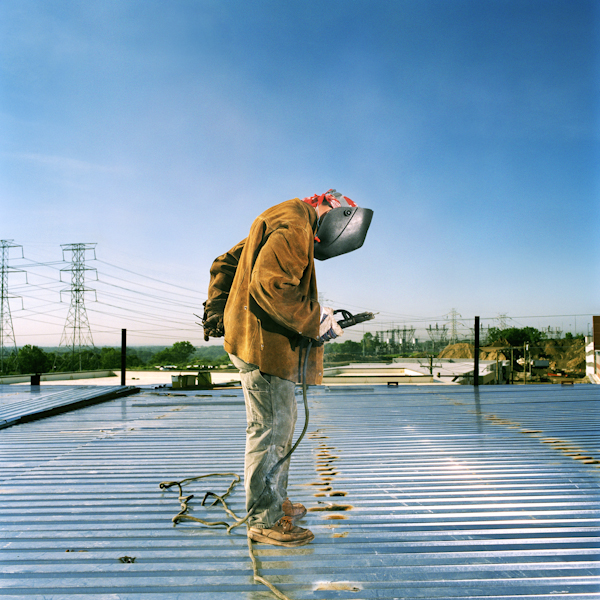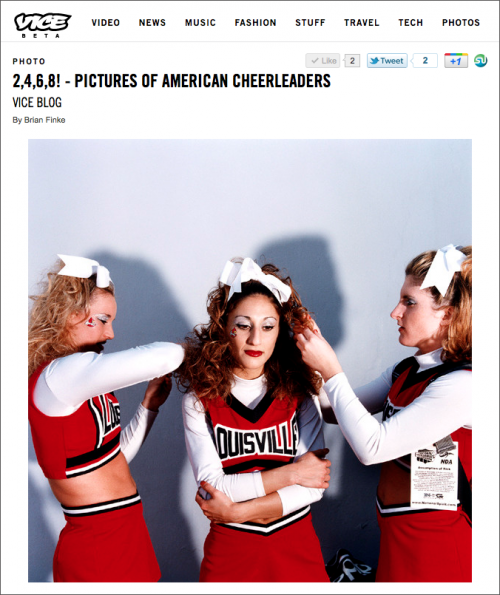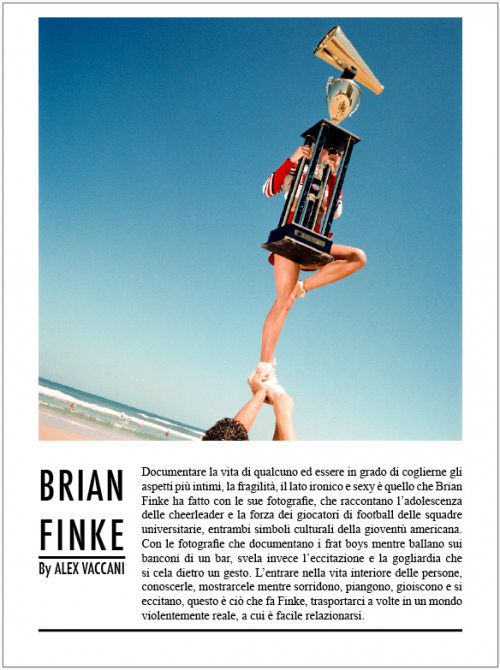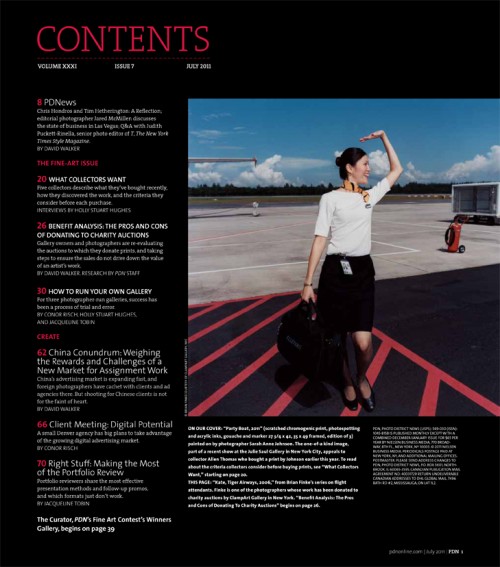



By Edith Zimmerman @edithzimmerman
Photographer Brian Finke is known for his pictures of groups -- of flight attendants, bodybuilders, and cheerleaders -- and his latest project focuses on construction workers. “Construction” is currently on display at ClampArt gallery in Chelsea, and available in print from Decode Books. Brian and I talked recently about his projects over drinks in Brooklyn.
Brian Finke: So your favorite picture from “Construction” I know.
Edith Zimmerman: Right, the hot guy with the Mountain Dew. I want it for my apartment, but it might be weird to have a picture of a stranger looming so large in a studio. Maybe I'd put it in my bathroom.
BF: But you can't put it your bathroom, because of the humidity.
EZ: Right, right. I'd find a way, though.
BF: [Laughs.] Any other ones you like?
EZ: Any pictures of hot guys. Also hot girls! I like your sensibility, because there's a dirty-ish aspect: you give people the opportunity to look really closely at someone's face -- their pores, their sweat, the curve of their lips -- and since that's generally not acceptable in real life, you feel a little guilty, but it's irresistible.
BF: It's the same thing with the process of taking pictures -- it gives you the chance to stare at people and be judgmental, because otherwise [without the camera] it'd be pretty awkward. But that kind of looking and seeing -- to a certain extent I think I'm a very easy person to be around, because I can talk, but I'm not intrusive or intimidating.
EZ: I would agree with that. To what degree do you fall in love with the people you're photographing? And does it happen when you're there with the camera in their face, or later when you're alone with the picture?
BF: I like that. To get so involved, and spend so much time, I really do have to fall in love with it that way.
EZ: But I mean the individuals. Flight attendants, football players.
BF: It's kind of a love-hate with the individual pictures, because you see 'em so much. And then some of the pictures that become popular -- you could love them AND hate 'em because you get kinda sick of reprinting them.
EZ: Like playing your greatest hit?
BF: Yeah. But about revisiting subject matter, and whether it's boring -- for instance, ESPN the magazine hired four photographers to cover different aspects of this giant pep rally at the University of Kansas called Midnight Madness. I was like, "I want to shoot the cheerleaders!" but they were like "The crowd." So I took some picture of fans -- but then I made some nice new, beautiful cheerleader pictures.
EZ: Well cheerleaders are very PRETTY, so there's also that.
BF: Right. [Laughs.] There was this one picture I made, it felt so nice, and to me was totally different than all the other cheerleader pictures I’ve made. So they're practicing on the basketball field before the game, and there was this one girl -- also when I'm shooting I get crushes on people --
EZ: I asked that! Brian, I said, "Do you fall in love with the people you're shooting?"
BF: [Laughs.] I was talking to a photo editor at a party a few months ago, I was totally drunk and talking a lot, saying that I really get crushes on people when I'm shooting -- like you're physically drawn to them --
EZ: This is what I ASKED. I just want to put that out there. Anyway, glad we're coming around.
BF: So yeah, with this cheerleader, it was her blonde hair, and how it fell just below her ears, and there was this great red lipstick, and the royal blue of her uniform, and there was this one shot where she was staring at me, this deadpan stare, and the background went black, and it was just amazing. That look of indifference, and then the style and aesthetics. And yeah, the physical attraction, of course. It's awesome. Such a good picture.
I think photography in general is very intuitive; it doesn't have to make sense. I'm good at obsessing about things. I can commit to something, and stick with it, and delve into it, and I don't get sick of it for a long time. And even when I do, it's just like moving on to a slight variation, really. It's very repetitive. And I mean even the books, they're all the same size. They're all square.
[His three photography books are stacked between us on the table, and he touches them on all sides.]
EZ: You're making like your own Brian Finke totem.
BF: It's my boxed set!
EZ: How did being drawn to more attractive people play out on the construction site?
BF: I was like, "This is going to be the hottest construction site ever!" It was a conscious decision; I want to take pictures of people I want to look at. It's not necessarily like people always have to be, quote unquote, good looking, it’s just that there’s something about them.
EZ: Is it harder to photograph someone you know than to photograph a stranger?
BF: Yeah.
EZ: And are friends ever disappointed that you don't take pictures of them? Or maybe I'm just shedding light on my own --
BF: You want your picture taken?
EZ: No! Well --
BF: There we go! [Laughs.] Last night I went out with my agent from Milan, and we were taking pictures at dinner, and she was like "YES" -- she was being sincere -- like, "Ahh you took my picture!"
EZ: See?
BF: I was just like -- it didn't really cross my mind. She just had these great red nails, this great red phone, and this great red lipstick. So, maybe if you put some makeup on?
EZ: Fuck you! [Laughs.] I HAVE makeup on. I have eyeliner on. Shit. Okay.
BF: See, now you know my fetish, the red thing, the red lipstick. It's a fetish thing, really, photography.
EZ: That should be your next book, Women in Red Lipstick. But no, actually your next series is on the US Marshals. How's that going?
BF: This past weekend I went to Texas, and one of the pictures I got there was of these two Marshals who look like they're 15. But they have these giant guns, and one of them looks like Steve Urkel, with this little awkward giggle, and they're in this person's home. It's just very awkward and wonderful. Being physically WITH people when I take their picture, being very close to them -- I like that proximity. You can see how the person holds himself.
EZ: Can you give me a picture of that hot guy from the construction site?
BF: [Laughs.] I'm happy to.

















